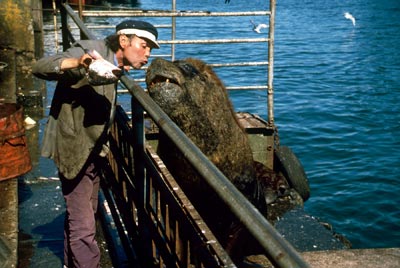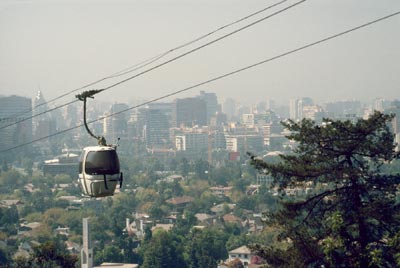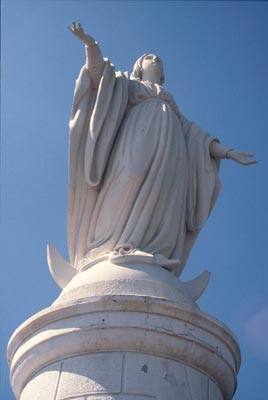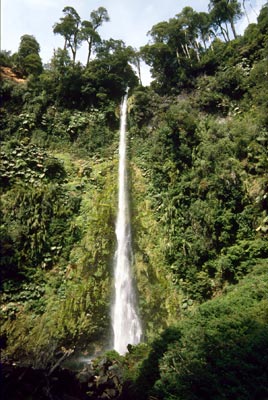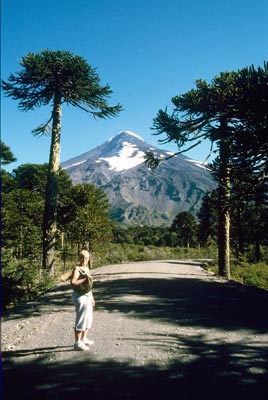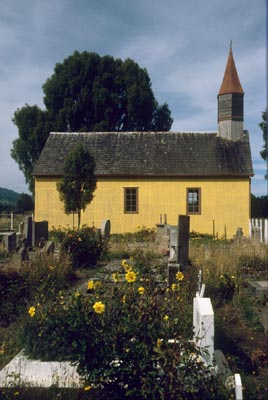Exploring Chile — from its cities to the famed Lake District
Steve Cole, Lowell, MI
“Wow! They’ve cloned Ricardo Montalbán,” my wife, Sharon, exclaimed the first time we emerged from our hotel onto the streets of Santiago’s upscale Providencia area.
My first impression, too, was that there were a lot of strikingly good-looking Chilean men and women, and anyone under the age of three was absolutely too cute for words.
Adding to their good looks, the citizens of Chile’s capital were extremely well dressed. Even more striking was the fact that young people were neatly dressed and well groomed — no calf-length baggy shorts, no black T-shirts and not one baseball cap anywhere!
City shopping
We discovered several upscale department stores in our exploration of Santiago. We particularly liked Paris and Falabella, where even the security guards were dressed in suits and ties.
We found good-quality men’s dress shirts for around $30 each and silk ties in bright jewel tones for a mere $10 to $20. Well-tailored suits could be had for $200. Women’s and children’s clothes, however, were priced closer to what one would pay in America.
But, other than clothing, there were few unusual items to buy. Two large craft markets mentioned in guidebooks were permanently closed, and we could not find native arts in any shop.
However, Chile is one of the few places in the world where lapis lazuli is abundant, and several shops were devoted solely to jewelry and small decorative objects made from the bright blue stone.
Our most interesting find, though, was a selection of photographs of Santiago taken a century ago, which we purchased from a sidewalk vendor for about $1 each.
In and around Providencia
When you want a break from shopping and a chance to do some serious people-watching, there are thousands of small restaurants and snack shops in the area where you can get a bite to eat and watch the passing parade.
We desperately wanted some authentic Chilean food but couldn’t find it anywhere. Moreover, fine dining of any nation was hard to find in Santiago, and we soon tired of the ubiquitous ham-and-cheese sandwiches. After a few days we welcomed some American fast food, which we took to our hotel room.
Providencia is dotted with “aparthotels” that offer suites with mini-kitchens. Our accommodations at Providencia Suites (2087 Diego de Velazquez St.; e-mail psuites@rg.cl) featured a sitting room, a sparkling bathroom and a small but adequate modern kitchen. On a couple of occasions we cooked simple meals with supplies from a supermarket.
To explore more of Santiago than just its fine shops, we set out one morning from our hotel near the intersection of Pedro de Valdivia and Av. Providencia and headed north past low-rise apartment buildings whose balconies were draped in lush potted plants.
Within a few blocks we crossed the Río Mapocho and encountered a sculpture park with striking modern works scattered across a green lawn flanking the river.
Continuing north, we entered an area of what has to be some of the most expensive real estate in Latin America — single-family homes with large gardens and swimming pools within sight of the city’s skyscrapers. The areas of Las Condes and Vitacura, adjacent to Providencia, are said to be more upscale, but we saw nothing there to top this residential area.
Park visits
Just beyond the residential neighborhood we came to the base of the mountain that comprises Santiago’s beautiful Parque Metropolitano (also known as Cerro San Cristóbal), which contains a botanical garden, a zoo, picnic areas, foot and bike trails and two municipal swimming pools. (Despite afternoon temperatures in the low 90s, the pools were closed for the season.)
Although roads provide park access for cars and bikes, most people take the cable cars that ascend the several hundred feet to the top in just a few minutes. At the halfway point you can disembark for the botanical garden and pools. At the top terminal there’s an open-air restaurant where you can enjoy dramatic views of the valley in which Santiago lies — but only on the rare days when heavy smog does not obscure the view of the city spread out below.
Beyond the restaurant, a gentle path leads visitors several hundred feet higher to an amphitheater where outdoor Masses are held. Above that, you ascend to a white statue of the Virgen de la Inmaculada Concepción, whose arms reach out as if to embrace the entire valley and the snowcapped Andes in the distance.
A mini-version of Parque Metropolitano, located closer to the city center, is Cerro Santa Lucía, a small, steep hill that provides some impressive views of the city.
Equally pleasant is the flat Parque Forestal that meanders along the river. A few blocks away is the Plaza de Armas, the heart of Santiago and the place where you’ll find the colonial-era churches, museums and other buildings that seem to be requisite for every Latin American capital.
Plaza de Armas
The Plaza de Armas is noticeably more run-down than Providencia, and we were glad we did not opt for a hotel in that area. However, the plaza was bustling and appeared perfectly safe in the daylight hours.
We enjoyed Casa Colorada, a well-preserved colonial mansion housing a small museum that gives just enough — but not too much — of a taste of local history. We also enjoyed the cathedral.
Originally built in 1541, the cathedral was destroyed by fire, rebuilt and destroyed twice more by earthquakes, being rebuilt after each. The present structure dates from 1789.
Near the Plaza de Armas you’ll also find the interesting Museo Chileno de Arte Precolombino, a repository of pre-Columbian art, in addition to several other historic structures.
Chile’s most famous intellectual is the late Pablo Neruda, who won the Nobel Prize for his poetry in 1971. At least three of Neruda’s houses plus other sites associated with the poet exist in Santiago or nearby and draw fans from around the world.
All of Santiago’s sights are within easy reach, thanks to an excellent, easy-to-use subway system. Fares vary during rush hours but average about 75¢, regardless of the distance covered.
Valparaíso & Viña del Mar
Side trips from Santiago include the wine country, to the south, where Chile’s world-famous vintages are produced. However, expat Americans warned us that not many wineries there have tasting rooms and we should not expect an experience like that of Napa Valley. Instead, we opted for a day trip to Chile’s largest seaport, Valparaíso, an hour away by bus.
Valparaíso’s chief attractions are the ascensores, small trolley-like cars that climb the bay’s steep hills on tracks. Locals use the ascensores to reach their homes while visitors enjoy the ride for the views of the colorful pastel houses dotting the hillsides.
Ascensor Artilleria brought us to a small park with fine views of container ships unloading in the busy harbor. Nearby is a naval museum which has some interesting displays but is devoted mostly to famous naval personnel in Chilean history.
Valparaíso is a rough-and-tumble port and smells it, so we moved on a few miles down the coast to Viña del Mar, a far more upscale resort town that is packed in summer with Santiago residents wanting to escape the heat in the capital. Even in the so-called off season, in March, Viña del Mar was uncomfortably crowded and offered no attractions that were out of the ordinary, so we soon caught a bus back to Santiago.
Our next stop — and the main focus of our trip — was Chile’s famous Lake District.
The Lake District
Before leaving home, we had tried to get information on the best sites to see in the Chile’s vast Lake District, but we ran into snags.
“Insight Guide Chile” contained some stunning photographs but was short on practical information. We found that “Fodor’s Chile” had more meat, but often the information was outdated or inaccurate.
Chile’s tourism office in Washington didn’t return our phone calls or e-mails. In the end, a diplomat at Chile’s embassy sent us some brochures that covered the half dozen national parks and 11 major lakes that sprawl across this 240-mile-long district.
To avoid a tedious 400-mile drive to reach the Lake District from Santiago, we flew to Temuco, a city that serves as the jumping-off point for tours of the area.
Temuco’s tiny airport belied the fact that this is a modern city with branches of Santiago’s upscale department stores. What’s more, Temuco’s central market had several restaurants offering Chilean dishes, including cazuela, a broth containing hunks of meat and potato; humitas, mashed corn steamed in corn husks; pastel de choclo, a sort of pot pie containing ground meat and corn, and empanadas.
Well fortified, we climbed into our rental car and headed for the resort town of Villarrica on the shore of Lago Villarrica, an hour’s drive away. Our goal was reaching the outstanding Hostería de la Colina (phone/fax 56 45 411503, www. hosteriadelacolina.com), owned by Americans Glen and Beverly Aldrich.
The hotel has only seven rooms, but what rooms they are! All are large, comfortable and spotless and have gorgeous views across lush gardens to the lake and the smoldering, 9,350-foot Volcán Villarrica on the other side. Our room (Room 2) cost $88 per night.
The Colina’s small dining room served gourmet meals, and we sat down to outstanding chestnut soup, salad and pork chops in an unusual molasses sauce. For dessert there was homemade ice cream in a variety of flavors, including raspberry and blueberry.
More than just lakes
After dinner, Glen told us that there was more to the Lake District than just lakes. He supplied us with lots of information on nearby sights and gave us hand-drawn maps that proved exceedingly useful. Hardly anyone in Chile speaks even rudimentary English, so to get detailed directions in our native tongue was a godsend.
The next morning, after a hearty American-style breakfast, we set off with Glen’s maps to look for various saltos, or waterfalls. Chile is famous for its waterfalls, which seem to spurt from nearly every rock face. Many saltos are located in the national parks, but many more are on private land where you can pay a small fee of a dollar or two to visit the cascade.
Our first stop was the privately owned Salto la China, where we walked a few hundred feet through a cool bamboo forest before suddenly coming upon a clearing where a 10-story-high, 3-foot-wide band of water came whooshing down a vine-covered cliff.
Our next stop was Salto del León, also privately owned and set back in a forest a few hundred feet from the road. León was wider than China Salto, and the water dropped to a rocky pit then tumbled out to fall a few more feet before churning along relatively flat ground to join some distant river.
Walking to Argentina
The Villarrica area is not far from the border of Argentina, and we thought a visit to that country would be a fun way to celebrate our anniversary the next day.
Armed with Glen’s map, we drove to the famous and lively resort town of Pucón and continued through a couple villages before the tarmac turned to rough gravel and started a winding ascent into the mountains. Soon we passed Caren Salto, where we took a relaxing walk through a gorgeous, sheep-filled meadow to the shepherd’s private waterfall.
Twenty-five miles farther on we stopped at one of Chile’s few scenic turnoffs to view a large waterfall tumbling down the side of a cliff on the other side of a deep valley. Another five miles brought us to a small lake that reflected the surrounding mountains.
At last we came to Chile’s deserted frontier post, where bored Customs officials were playing Ping-Pong. We told them we just wanted to cross into Argentina for a little while. They said we couldn’t take our rented car across the border but we could walk the three or four kilometers to Argentina’s border post.
So we parked and set off along a hot gravel road which offered splendid views of mountains and hundreds of Chile’s majestic araucaria trees, a conifer native to the Southern Hemisphere that can live more than a thousand years. Soon we came to a sign welcoming us to Argentina and we walked on for another 1½ kilometers to Argentina’s border station.
The staff there couldn’t believe that all we wanted to do was have our passports stamped to show that we’d officially entered Argentina and then walk back into Chile. With broken Spanish and “sign language,” we explained that it was our anniversary and our present to ourselves was a visit to Argentina.
A middle-aged female supervisor thought our anniversary story was cute and she told a young guard to admit us. Stamping our passports, he said under his breath, “Idiots!” We hiked back to Chile, and the equally mystified Chileans welcomed us after our brief sojourn out of their country.
My son Bryan and I have a friendly rivalry over the number of countries each of us has visited. Just a few months before, he had made his first trip to Argentina and this was my first.
Area attractions
We used Glen’s maps for other scenic drives and short mountain hikes in the area. Especially enjoyable was a nearby hot springs, actually three indoor and two outdoor swimming pools filled with mineral water of varying temperatures piped from an underground source.
We also took Glen’s advice to visit the city of Valdivia, a few miles up the Río Valdivia from the Pacific coast and just a 1½-hour drive from Villarrica.
Valdivia’s most popular attraction is the city’s colorful riverside fish-and-vegetable market. Huge sea lions swim up to the concrete seawall behind the market to gorge on fish heads and guts tossed to them by the dozens of fishmongers.
While there, we heard the beat of tom-toms, then saw a group of Mapuche Indians dressed like characters from a 1950s B Western stomping their feet to the drums while someone from their group worked the crowd, trying to sell a CD of the “music.” It was a sad commentary on the current state of Chile’s indigenous population.
Driving a little ways out of town, we discovered Cabañas Puerto Pelícano (Camino a Niebla Km 7, Casilla 194, Valdivia; www.puertopelicano.cl [in Spanish only]), where we got a 2-bedroom cottage with a fireplace, a full kitchen and a great view of the broad river for $48.
Guarding the river’s mouth a few miles farther on are two old Spanish forts, one on the mainland and a more interesting one on a tiny island reached by a water taxi.
A bit off track
The next day, an hour’s drive brought us to Parque Nacional Puyehue, said to be Chile’s most popular national park. Apparently, Chileans can locate the park’s attractions without signs, but we weren’t so lucky. Heading up into the mountains on a gravel track that we were told led to some waterfalls, we passed a gorgeous lake but no falls.
After a bone-jarring 12 miles, we unknowingly left the park and came, quite unexpectedly, to Antillanca Ski Resort (O’Higgins 1073, Casilla 765, Osorno; www.skiantillanca.cl [in Spanish only]).
The resort was closed, but there was a handful of employees getting things ready for the upcoming ski season, and the affable manager agreed to give us our choice of the 350 vacant rooms. None of the rooms we saw was worth the $72 tab (double that in season), but it was late in the day and we had no choice.
The next morning the manager suggested we take the resort’s service road higher up into the mountains to its end at the crater of an extinct volcano. Sitting silently in a crater bowl strewn with black volcanic rock proved to be a very enjoyable commune with nature.
Lake Llanquihue
Hiking farther up a slope afforded us views of snowcapped peaks straddling the Chile-Argentina border. One peak, 8,698-foot Volcán Osorno on the shore of Lago Llanquihue, was our next destination.
Llanquihue is the Lake District’s largest lake, and Volcán Osorno, which can be seen from any spot along the shore, is the district’s best-known volcano.
The gateway to the area is the picturesque town of Puerto Octay, which was settled by German immigrants and has a Bavarian feel, especially apparent at 95-year-old Hotel Centinela (phone 64 391 326, www.hotelcentinela.cl).
The Centinela’s cozy lodge looks like it was transported from Europe and was tempting, but we opted for one of several cabins with kitchens ($75) overlooking the lake. We arrived at sunset and from our deck were treated to a view of Volcán Osorno glowing pink across a mauve lake.
From the Centinela we explored the area’s rolling countryside, dotted with small churches painted in bright colors and a seemingly endless supply of cabanas for rent.
Although all of Chile’s larger lakes have some resorts with facilities for watersports and other activities, outside these resorts we saw few beaches or boat liveries. Many beaches were on private land and the owners charged admission fees.
The water seemed clean, but the volcanic sand was black and unappealing to us Michiganders used to the golden beaches of the Great Lakes. Despite very warm weather in late March, all beaches were closed for the season.
One day we took a bumpy gravel road to the opposite side of Llanquihue from the Centinela to get a closer look at Volcán Osorno. As with one or two of Chile’s other 55 active volcanoes, you can hike to the top, but we opted to drive. The road ran out about three-quarters of the way to the top, where there were splendid views of the mountain and the surrounding countryside. However, most of the Lake District’s mountains are low and the views do not compare to the Rockies or Alps.
The towns on Llanquihue’s shore each had a different feel. Ensenada was tiny and offered little, while Puerto Varas was too busy and touristy for our taste. Frutillar, on the other hand, was quaint and offered a nice lakeside promenade, a beach and, in summer, a music festival. The craft market, however, like others in Chile, offered mostly cheap souvenirs bearing the town’s name.
The end of the Lake District
The southern tip of Lago Llanquihue marks the end of the Lake District. Many travelers choose to drive a few miles farther south to the town of Puerto Montt, but some Americans we met who had just been there said it wasn’t worth it.
Instead, we drove an hour beyond Puerto Montt and caught a ferry to the much-touted island of Chiloé. Unfortunately, Chiloé was not scenic and the two major towns, Ancud and Castro, were run-down.
Castro did have a number of inexpensive harborside restaurants offering bargain-priced fish dinners. We paid less than $10 per person for a large portion of sea trout plus French fries and a “Chilean salad” consisting of excellent sliced or chopped tomatoes, a little onion and chopped cilantro with an oil-and-vinegar dressing. A bottle of wine added only $6-$10 to the tab.


